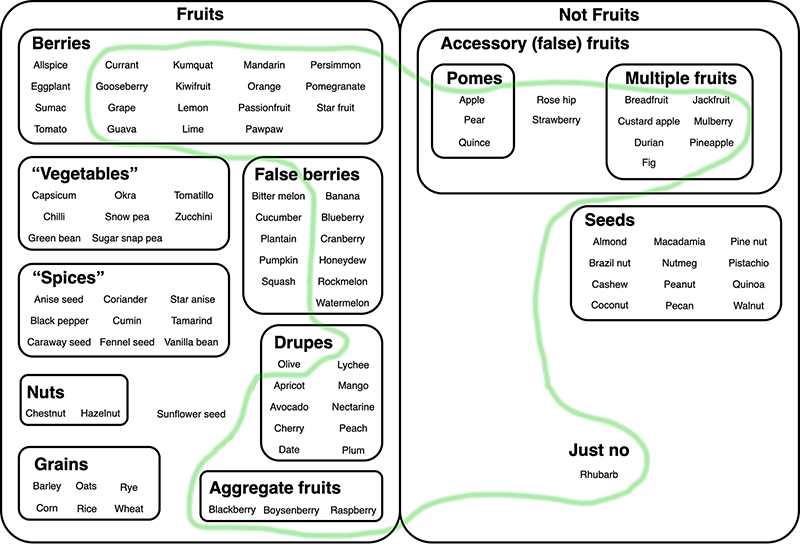Well, the weather forecast for Monday has been increased in temperature to 38°C for Sydney. Which is going to be the hottest day here for over 2 years (because of the unusually cool weather we’ve been having due to the La Niña for the past few years). Good news: our new air conditioner has been delivered. Bad news: it still won’t be installed until Wednesday. So, we’re stuck without a functional air conditioner on the hottest day for over 2 years. It’s not going to be fun here tomorrow.
Today I assembled a week’s worth of Irregular Webcomic! strips, and wrote and made a new Darths & Droids strip. I also planned some new future lessons for my ethics classes, which in a few weeks will tackled the topics of Photography (for ages 10-12) and Death (ages 13-15).
And for a bit of fun today I drew up a diagram of fruits by botanical definition. This is a long-standing humorous topic between me and my friends, when we point out that various things are or aren’t fruits by various definitions. I was prompted to actually make a list and then a diagram by my current reading of Harold McGee’s On Food and Cooking, which contains technical information about many foods.
So here’s the diagram:

The groupings are by botanical definitions. The green line encircles what people generally refer to as “fruit” in culinary terms. I showed this to some friends and got the comment that they didn’t consider avocados to be culinarily a fruit. I was a bit surprised. I don’t eat avocados myself – they’re one of my least liked foods – but I did have the impression that most people considered them to be fruits. (I consider them to be horrible slimy things.)
They also questioned rhubarb. Now I don’t mind rhubarb, but I’ve never bought it or prepared it myself. I personally don’t consider it a “fruit” in a culinary sense (because it’s so obviously a stalk), but I’ve read that a lot of people do, which is why I included it in the green curve.
New content today:

It was 38 degrees here when I read your blog.
Of course, we use Fahrenheit. So what, 3C?
European living in the US here. Surprisingly, I think that Fahrenheit is the one non-SI unit that makes a certain sense, and that can easily coexist with other SI units.
Why? Because Celsius is pretty arbitrary as well, and does not work by itself with the other SI units anyway. If you want to use it in equations, you have to convert to Kelvin anyway. Sure, Celsius is just an offset to Kelvin, Fahrenheit also needs to be scaled… but when you’re using Kelvin, you’re not so likely to think about “weather temperatures” anyway. If you do, conversion is still trivial.
Living in the US now, I appreciate what Fahrenheit does for the aforementioned “weather temperatures”. Celsius is “cramped together”, a single degree or even half makes a big difference. Fahrenheit? It’s easy to say or hear “the weather is in the 70s today”, or in the 80s/90s/100s, and you know how to dress or what to expect. I have a simple mental map from Fahrenheit decades to felt temperature: 30s freezing, 40s too cold, 50s cold, 60s cool, 70s “regular weather”, 80s warm, 90s hot, 100s be careful leaving the house.
The other non-SI units, especially those weird odd numbers of inch in a foot, or even that fraction convention for inches (e.g. 1 3/8”, and then tools and even rulers are marked like that!) make life harder.
By the way, some neat “magical” conversion tricks:
Because there are almost 3.3 feet in a meter, when you square that it’s close to ten. So if you see square feet, remove the last digit and you have almost square meter! Definitely enough precision when talking about apartment sizes.
A similar thing works with gallons and quarts. A quart is a popular volume for e.g. milk cartons and other beverages. Because it’s 1/4 of a gallon, which is about 3.6 liters, a quart works out to about .945 liters.
So if you’re buying a quart of milk, for all intents and purposes you’ve bought a liter of milk, the most popular beverage size in Europe!